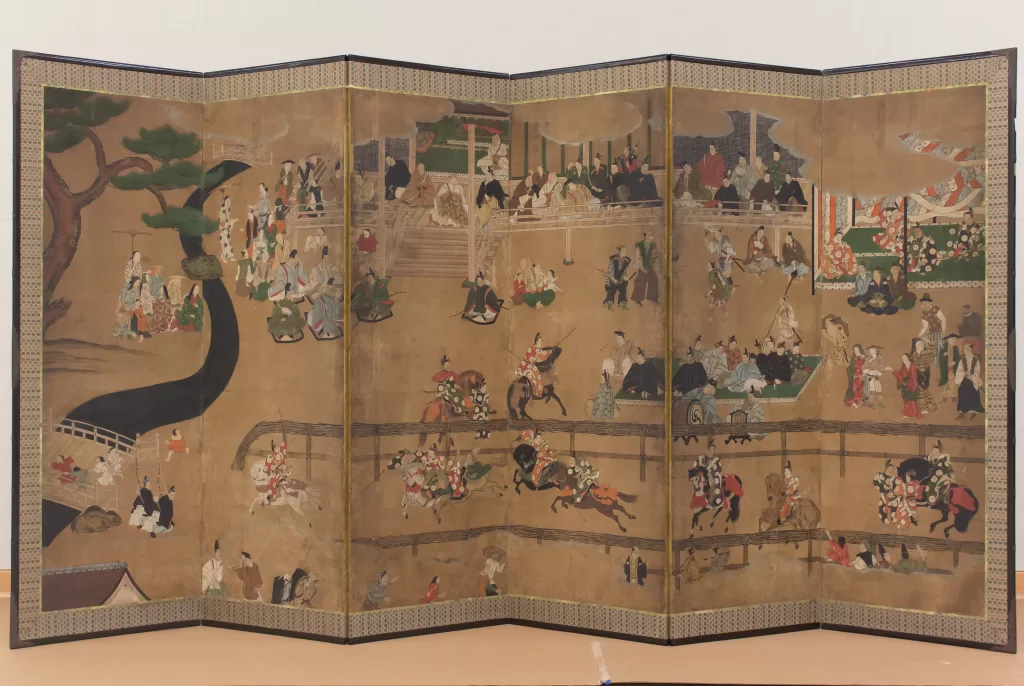Kamo Kurabeuma: An Age-Old Ritual Horse Race in Kyoto
The much-anticipated Kamo Kurabeuma, a unique and historic horse race, will once again occur on May 5th at Kyoto’s Kamigamo Shrine. This highlights the commencement of a series of influential rituals preceding the grand Aoi Festival celebrated on the 15th of May.
It’s one of the most anticipated Kyoto events in May.

Historical Background
Born from Emperor Horikawa’s vision in 1093, the Kamo Kurabeuma is famously credited as Japan’s primary horse racing event. It has achieved this fame through nearly a thousand years of annual occurrences that have earned it recognition as an Intangible Folk Cultural Property of Kyoto, signifying its rich history and religious significance.
Each year stands as a reflection of the renowned Heian period procession when imperial representatives would journey to visit the Kamo Shrines. Making their way through rows of witnessing spectators, they honor history in borrowing the noble Heian style.

A Unique Competition
Differing considerably from a standard modern horse race, there are two teams involved in Kamo Kurabeuma: Sakata and Ukata. Representing Kamigamo Shrine, Team Sakata dons vermilion clothing, while Ukata champions wear brown or black to represent Iwashimizu Hachimangū. Unlike typical horse races where competitors start down the track simultaneously aiming to cross the finish line first, in this event one horse commences a decided distance ahead of its competitor.
The thrilling competition consists of several rounds usually numbering six rounds. It unfolds under the premise of tracking whether or not the gap between horses shortens or elongates by the conclusion of each race rather than simply who crosses an arbitrary finish line first.
To pay homage to past victories since Emperor Horikawa’s initial presentation almost millennia ago, Kamigamo Shrine’s team is traditionally given a default win for the first round.
The Ritualistic Elements
On this day filled with traditional pomp and pageantry, there are three significant portions participants and audiences alike eagerly anticipate: a morning ritual, prayers for safety and success pronounced by riders and culminating in perhaps what most look forward to – the electrifying races themselves.
An integral part of these preparatory rites involves creating a temporary sacred space for deity Kamo Wakeikazuchi no Okami beside the track. Faithful adherents transfer this deity here from his usual shrine placement to preside over proceedings.
Preparations extend beyond spiritual matters with riders undergoing formal health inspections ensuring all on horseback can cope with the intense demands of riding at full speed down a carefully prepped 200-meter track spanning between Kamigamo Jinja’s first and second torii gates. All these preparations coalesce with prayers for peace across Japan and bountiful harvests alongside purification rites involving ceremonial sake drinking alongside sacred sakaki branch offerings.
Riders also partake in their unique ritual involving riding horses along established sun and moon patterns reflecting yin-yang philosophy integral to Kamigamo Jinja beliefs since ancient times. Strikingly garbed riders gallop down tracks crooning encouraging words toward horses they spur towards dictated goals.
English translations are provided during these events catering to both local Japanese and international spectators alike ensuring everyone appreciates every exciting ritualistic moment this cultural program offers.
Kamo Kurabeuma offers not just exhilarating horse races but profound cultural experiences witnessed in ancient rituals leading up to Horse race itself making it an event worth marking on calendars.
By the way, if you’re in Kyoto during the whole month of May, check out the Iris bloom season. Iris Bloom Season is a breathtaking spectacle of vibrant colors and delicate beauty you won’t miss.